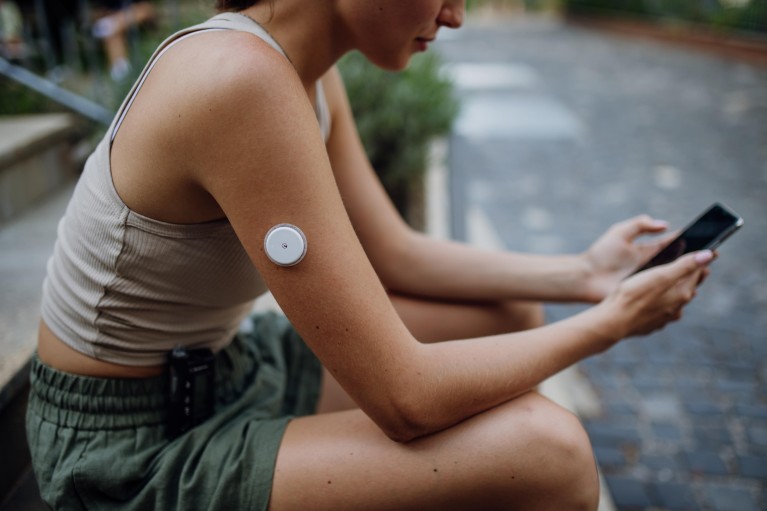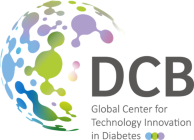
A continuous glucose monitor is common for diabetes management. This device could also form part of an 'artificial pancreas' being developed with funding from Diabetes Center Berne.Credit: Halfpoint/Getty
“An average person with type 1 diabetes (T1D) will make more than 150 decisions about their disease management every day,” says engineer José García-Tirado, who is a professor at the University of Bern, Switzerland. These can relate to self-care, treatment, food and nutrition, and lifestyle. “Those decisions are critical and impact how well their overall health is controlled. Our research aims to reduce this burden.”
García-Tirado is developing an ‘artificial pancreas’ to achieve fully automated insulin delivery for people with diabetes. Many people currently use a continuous glucose monitor — a sensor under the skin that measures glucose levels every five minutes from the tissue fluid — to aid their decision-making.
The glucose sensor is one component of the artificial pancreas. Another is a pump, which injects insulin into subcutaneous tissue to maintain the basic levels needed to survive. However, people with diabetes must still provide details of real-time events, such as how many carbohydrates a particular meal contains. Depending on their specific glucose levels, the system will then infuse the required insulin dose.
“A fully automated artificial pancreas could learn a person’s daily glucose patterns and respond without being prompted. This would be a game-changer,” says García-Tirado. “We’re developing a state-of-the-art control system to act as the brain for the artificial pancreas.”
García-Tirado has worked in Bern since 2023, when he took a professorship funded by the University of Bern and Diabetes Center Berne (DCB) — a privately-run, non-profit organization founded in 2017. DCB also funds other positions at the University of Bern, such as that of physicist and sensing expert Lilian Witthauer, who joined in 2021 as a professor. While part of García-Tirado’s work is focused on achieving fully automated glucose management, Witthauer wants to improve current sensing technology.
Shining a spotlight on sensing
Witthauer’s group is conducting three interdisciplinary projects, the first of which aims to measure glucose in real time in people with diabetes. For this, the team is developing an optical sensor. “Current sensors measure glucose in the subcutaneous tissue, which means the measurement is delayed with respect to the true blood glucose values,” says Witthauer. “This delay leads to inaccuracies when glucose levels change fast, for example, during food intake, exercise and illness. An implantable optical sensor would use light to pick up glucose levels directly from the blood, enabling accurate, delay-free readouts.” The optical sensor could also be used to measure other metabolites. “We must move on from just measuring glucose and monitor other metabolites such as cortisol (a stress indicator) and lactate (an important metabolite during exercise). Multi-analyte sensors would allow monitoring and management of other diseases in people with diabetes.”
The second project involves a clinical study measuring hypoglycaemia symptoms during sleep. To do this, the team is using smartwatches and ceiling-mounted radar sensors, as well as developing algorithms for data analysis. Hypoglycaemia triggers multiple symptoms, including changes in breathing and heart rate. Witthauer hopes to implement this system in long-term care facilities to alert staff to hypoglycaemia. “This will add another layer of security to diabetes management in this vulnerable group,” says Witthauer.
Finally, Witthauer’s group is analysing the different components present in people’s breath. This could provide insights into all forms of diabetes. “We’re interested in how the composition of breath changes in different glycaemic states,” says Witthauer. “Furthermore, we want to know how molecules in exhaled air differ in people with and without diabetes, to improve our understanding of the disease.”
The menstrual cycle and diabetes
DCB runs its own research projects too. Martina Rothenbühler, scientific program manager at DCB, is involved with its menstrual cycle project, which is run in collaboration with US non-profit organization and diabetes app developer Tidepool. It aims to make diabetes data more accessible, actionable and meaningful.
Rothenbühler noticed that women with diabetes often said their hormonal cycles disrupted their glucose levels. “We did an initial data-extraction review, but existing studies had small sample sizes, no significant results and no harmonized way of defining cycle phases or measurements,” she says.
This led to the collaborative project which is asking women in the United States to donate their diabetes data from the Tidepool data platform, along with their menstrual cycle data. Rothenbühler hopes that the insights could translate to practical support like clinical guidelines and software solutions tailored to women with diabetes.
“In future, I plan to analyse and utilize data on a woman’s entire life cycle,” says Rothenbühler. “It’s vital to offer young women diagnosed with diabetes some perspective, support and tools that will help them navigate the disease throughout their lives.”
García-Tirado also hopes to find a way to protect people with T1D from the increased risk of cardiovascular disease and renal disease. Even if someone with diabetes has excellent glucose management, their risk of having heart disease or a stroke is twice as high as someone without it.
“We’re researching adjunct therapies — drugs that could be paired with our automated insulin system to protect against these risks,” says García-Tirado.
“Our mission is to support diabetes research and technological advancement,” says Rothenbühler. “We’re building bridges between research and startups, industry and other stakeholders.”
Resourceful support
DCB employs staff from diverse disciplines, including communications specialists, business developers, regulatory experts, scientists and technology developers. Through its work, DCB is building a multidisciplinary community spanning all aspects of diabetes research and practical management of the disease. For example, DCB’s data team is creating a diabetes data pool to help interested parties navigate and utilize the vast datasets available.
DCB works closely with the University of Bern, its associated hospital, and other research partners, while also forging a robust network within the industry and start-up community. Every year, DCB runs an innovation challenge for start-ups. Selected companies are invited to a bootcamp that includes mentoring sessions, product-pitch training, advice on clinical and regulatory affairs, data gathering and algorithm development. DCB is keen to establish long-term relationships with all involved in diabetes research and support across Switzerland and beyond.
“We support entrepreneurs and researchers through all the practical, regulatory and ethical processes that will bring their ideas to fruition,” says Rothenbühler.
DCB also holds its own Lived Experience Panel, connecting with the diabetes community worldwide, and inviting participants to contribute to discussions and research ideas for truly user-centric translational research. This, together with the access that DCB offers to industry, is invaluable to researchers, notes Witthauer.
“DCB is committed to translational research that will transform diabetes care for everyone,” adds Rothenbühler. “We all have a common goal: to make life with diabetes easier.”


